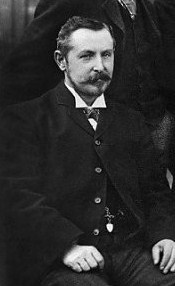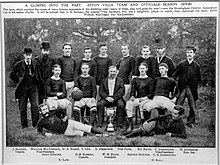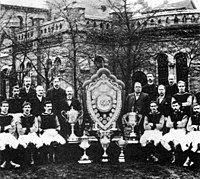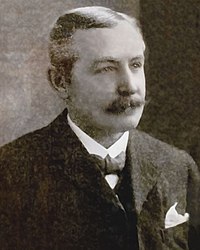George Ramsay
 | |||
| Personal information | |||
|---|---|---|---|
| Full name | George Burrell Ramsay | ||
| Date of birth | 1 March 1855 | ||
| Place of birth | Glasgow, Scotland | ||
| Date of death | 7 October 1935 (aged 80) | ||
| Place of death | Llandrindod Wells, Wales | ||
| Youth career | |||
| -1876 | Glasgow Rovers | ||
| Senior career* | |||
| Years | Team | Apps | (Gls) |
| 1876–1882 | Aston Villa | 0 | (0) |
| Teams managed | |||
| 1886–1926 | Aston Villa | ||
| * Senior club appearances and goals counted for the domestic league only | |||
George Burrell Ramsay (4 March 1855 – 7 October 1935)[1] was a Scottish footballer and manager.
George was the secretary and manager of Aston Villa Football Club in the most successful period of their history. As a player he was the first Aston Villa captain to lift a trophy, helping to establish the club as force in the game. A pioneer of the passing game, which he learned in his native Scotland, Aston Villa became renowned for their short, quick passing style under his leadership. His trophy haul of six League Championships and six FA Cups established Aston Villa as the most successful club in England. He has been described as the world's first paid football manager. [2]
Early life[]
Ramsay was born at Abbotsford Place in the Tradeston district of Glasgow.[3] His father was William Ramsay, an ironmonger, who originated from Perthshire. George's mother was Mary Ann Burrell who was born in Woolwich. The Glaswegian arrived in Birmingham around 1871 to work as a clerk in a brass foundry.
Playing career[]

Prior to joining Aston Villa, Ramsay had played for Glasgow Rovers.[4] In 1877 he appeared as a guest player for Welsh club Druids, when they played a fixture against Queens Park.[5]
Ramsay came to join Aston Villa almost by accident. Walking past a Villa players' practice match in Aston Park in 1876, he was asked to make up the numbers. Impressed by his skills, the Villa players invited him to join the club, and he soon became captain.[6] Ramsay later described the newly formed club's approach to the game as 'a dash at the man and a big kick at the ball'.[7] He also took charge of training which saw dramatic improvement that showed in the results, introducing what was known as the "passing game". This had become the main style of play in Scotland whereas in England most teams relied on what was known as the "dribbling game".[8]
"It was George Ramsay who first moulded the style of the club's play, and the Aston Villa team have never lost the reputation they gained for short, quick passing under Ramsay's direction".
— William McGregor, C.B Fry's Magazine 1904
In addition to the introduction of a radical change in playing style, Ramsay, along with John Linsay, discovered the Wellington Road ground at Perry Barr in 1876, which meant the club was able to charge admission for the first time. He was also responsible for the recruitment of Villa legend Archie Hunter, who later recounted the story in his 1890 memoir Triumphs of the Football Field.
Aston Villa to me as a club that had come rapidly to the fore and asked me to become a member of it. I hesitated for some time, but at last my friend told me that a "brother Scot," Mr. George Ramsay, was the Villa captain and that decided me. Mr. Ramsay was a Glasgow man and had exerted himself very considerably to bring the Villa team into the front rank.
— Archie Hunter, Triumphs of the Football Field
Villa played at Perry Barr until 1897, when the club moved to the Aston Lower Grounds, next to Aston Hall, which later became known as Villa Park.
Villa gradually improved under his guidance, which culminated in Villa winning their first trophy, The Birmingham Senior Cup, in 1880, with Ramsay as captain. The following season Ramsay handed the captaincy to Archie Hunter.
Management career[]


Ramsay retired from playing due to a knee injury sustained during a match against Nottingham Forest in June 1882, but remained involved with the club serving on the committee. Following the professionalisation of football in 1885, the club decided that it needed a full-time paid manager. The following advert was placed in the Birmingham Daily Gazette newspaper in June 1886:
'Wanted: manager for Aston Villa Football Club, who will be required to devote his whole time under direction of the committee. Salary £100 per annum. Applications with reference must be made not later than June 23rd to Chairman of the Committee, Aston Villa Club House, 6 Witton Road, Aston’
Villa received 150 applicants for the role, but with his strong association with the club George Ramsay was the overwhelming choice of the membership. Thus on 26th June 1886, Villa appointed what has been described as the world's first football manager.[9] The position predates the modern role of a football manager, the advert used the title 'manager' but the club settled on the title of 'secretary'. Ramsay was responsible for the team, including controlling recruitment and transfers, supported by a specialist trainer, who from 1893 until 1915 was . The team was selected by the committee each week, which consisted of such figures as William McGregor, Fred Rinder and, following their retirement, former club captains John Devey and Howard Spencer.
He held his position at the club for a remarkable 42 years, in which time Villa won the Football League and FA Cup 6 times each, establishing themselves as the premier football club in England. Villa's style of play under Ramsay consisted of high speed dribbling, short passes and powerful shooting.[10]
The Villa News remarked in October 1935 that: "He was not content that Aston Villa should be noted just in the playing sense; his demand was that it should become an institution with a world-wide reputation for probity in sportsmanship".[11]
Ramsay later said of his role in the establishment of Aston Villa as the most successful football club in England: "I have sewn an acorn and caused an oak tree to grow."[12]
In 1926, at the age of 71, Ramsay retired as secretary and became honorary advisor and a vice-president of the Club. His replacement W. J. Smith was unable to continue Ramsay's success, although the club did finish runners-up in the league twice under his guidance. In 1934 Smith stood down and the club decided to appoint its first manager, Jimmy McMullan. The following year Ramsay died at the age of 80. Within a year of his death the Midlands giants were relegated, an unthinkable notion in the Ramsay era.
In all, Ramsay's association with the football club lasted 59 years, a time which will always be known as Aston Villa's 'Golden Age'. Ramsay was laid to rest at St. Mary's Church, Handsworth, his gravestone reads "Founder of Aston Villa".[13]
Personal life[]
He married Fanny Elizabeth Warwick, an Aston girl, in 1893. They had two sons and one daughter.
Honours[]
Aston Villa
- FA Cup Winners (6): 1886–87, 1894–95, 1896–97, 1904–05, 1912–13, 1919–20
- Sheriff of London Charity Shield (2): 1899 (shared), 1901
See also[]
- List of English football championship winning managers
References[]
- ^ The Times, Wednesday, 9 October 1935; pg. 6; Issue 47190
- ^ "George Ramsay – The World's First Football Manager". Scottish Football Museum. Retrieved 17 February 2021.
- ^ https://www.scotlandspeople.gov.uk/ Statutory register of Births 644/9 154
- ^ "Sporting Life". 10 April 1897. Retrieved 11 June 2020 – via British Newspaper Archive.
{{cite web}}: CS1 maint: url-status (link) - ^ "Wrexham Guardian and Denbighshire and Flintshire Advertiser". 13 October 1877. Retrieved 11 June 2020 – via British Newspaper Archive.
{{cite web}}: CS1 maint: url-status (link)(subscription required) - ^ "Mens | AVFC".
- ^ "George Ramsay".
- ^ Grant, Michael; Robertson, Rob (2011). The Management: Scotland's Great Football Managers. Edinburgh: Birlinn. ISBN 978-1-78027016-6.
- ^ Lerwill, John (2009). The Aston Villa Chronicles 1874-1924. Aston Villa Ltd. p. 198. ISBN 9780956286109.
- ^ Lerwill, John (2012). Aston Villa - The First Superclub. A & JL Solutions. p. 37. ISBN 978-0956983312.
- ^ Lerwill, John (2009). The Aston Villa Chronicles. Aston Villa Ltd. p. 30. ISBN 9780956286109.
- ^ Lerwill, John (2010). Aston Villa The First Superclub. p. 51. ISBN 9780956983312.
- ^ Spencer, Stuart. "George Ramsay – The World's First Football Manager | Scottish Football Museum". Retrieved 24 January 2019.
- 1855 births
- 1935 deaths
- Aston Villa F.C. managers
- Aston Villa F.C. players
- Footballers from Glasgow
- Scottish football managers
- 19th-century Scottish people
- Scottish footballers
- Association football forwards
- People from Gorbals
- English Football League managers